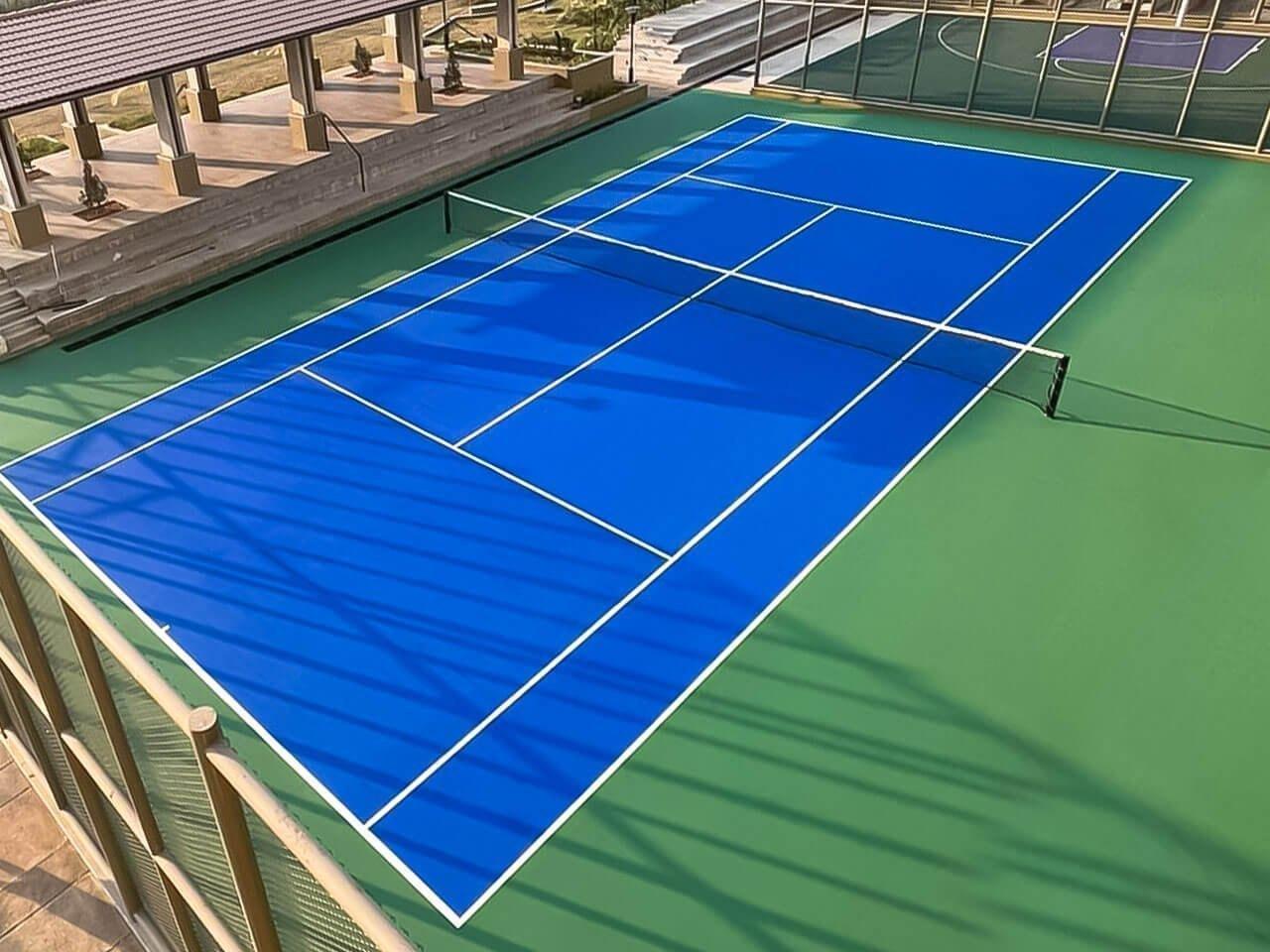Tennis Court Materials: Why Synthetic Acrylic is the Preferred Surface

When it comes to building or resurfacing a tennis court, choosing the right material is essential for ensuring performance, player comfort, safety, and long-term value. Among the available options—clay, grass, asphalt, concrete, and artificial turf—synthetic acrylic flooring has emerged as one of the most reliable and widely used materials, especially for outdoor courts.
This blog explores what synthetic acrylic flooring is, why it’s a top choice for tennis courts, and how it compares to other surface types in terms of durability, maintenance, and play quality.
Understanding Synthetic Acrylic Tennis Court Surfaces
Synthetic acrylic flooring is a multi-layered, non-slip, UV-resistant sports surface typically applied over a prepared asphalt or concrete base. This system is designed to deliver consistent ball bounce, optimal traction, and long-lasting durability in both recreational and competitive tennis environments.
The system usually includes:
-
A primer layer to bond the coating to the base
-
Multiple coats of acrylic mixed with silica sand for texture
-
Optional cushioned layers for added shock absorption
-
Durable line markings for court boundaries
This combination results in a surface that performs well in a variety of weather conditions and playing intensities.
Key Benefits of Synthetic Acrylic Tennis Court Materials
1. Consistent Playing Characteristics
Synthetic acrylic surfaces are known for providing a medium-paced court with reliable ball bounce and spin behavior. This consistency helps players improve their game and ensures fairness in competitive settings.
2. All-Weather Performance
Unlike clay or grass courts, acrylic surfaces are built to withstand sun, rain, and changing temperatures. They are highly resistant to UV radiation and do not fade or deteriorate easily, making them ideal for outdoor installations in diverse climates.
3. Slip Resistance and Safety
The texture of synthetic acrylic flooring is designed to offer superior grip, reducing the chances of slips or injuries. Optional cushioned systems are available to reduce joint strain, especially for older players or frequent use environments.
4. Low Maintenance Requirements
Once installed, synthetic acrylic tennis courts are easy to maintain. Regular cleaning and occasional resurfacing are usually sufficient to keep the court in playable condition for years. They do not require watering, rolling, or mowing like clay or grass surfaces.
5. Customization in Color and Marking
Acrylic surfaces can be finished in a variety of colors to match aesthetic or branding needs. Line markings are typically done with acrylic-based paints that resist wear and ensure high visibility during play.
Suitable Base Materials for Acrylic Tennis Courts
The choice of base plays a vital role in the overall durability and performance of the court. The most common base materials used for synthetic acrylic courts are:
-
Asphalt: Offers slight flexibility and is generally easier to work with during resurfacing projects.
-
Concrete: Provides a harder and more durable base but may require the addition of control joints and proper moisture barriers.
A smooth, well-leveled base with proper drainage is essential to the long-term performance of any acrylic court system.
Tennis Court Installation Process Overview
-
Site Preparation: Clearing, leveling, and compacting the site with proper slope for drainage.
-
Base Layer Construction: Pouring and curing asphalt or concrete base.
-
Surface Coating Application: Applying primer, base coats, textured finish layers, and line markings.
-
Drying and Final Checks: Ensuring even surface coverage and curing before opening the court for play.
Depending on weather conditions and court size, the process can take anywhere from 1 to 3 weeks.
Comparison with Other Tennis Court Surfaces
| Surface Type | Bounce | Speed | Maintenance | Weather Resistance | Lifespan |
|---|---|---|---|---|---|
| Synthetic Acrylic | Medium | Medium | Low | High | 5–8 years (before resurfacing) |
| Clay | Low | Slow | High | Low (weather-sensitive) | 1–2 years (regular upkeep) |
| Grass | Low | Fast | Very High | Low | Seasonal |
| Concrete (Bare) | High | Fast | Medium | Medium | 5–10 years |
| Turf | Medium | Medium | Medium | High | 4–6 years |
Synthetic acrylic surfaces strike a balance between performance, cost, and maintenance that other surfaces struggle to offer consistently.
Use Cases for Synthetic Acrylic Tennis Courts
-
Residential villas and private estates
-
Educational institutions and schools
-
Public parks and community sports facilities
-
Sports academies and tennis coaching centers
-
Club-level or recreational tournament venues
Whether you’re building a single court or a multi-court facility, synthetic acrylic flooring offers scalability and reliability across all settings.
Final Thoughts
Choosing the right material is one of the most important decisions in tennis court construction. Synthetic acrylic flooring offers a professional-grade surface that combines consistent play, low maintenance, and excellent durability, making it an ideal option for a wide range of court types.
Its ability to withstand heavy usage, changing weather, and intense gameplay—while requiring minimal upkeep—makes synthetic acrylic one of the best investments in sports infrastructure today.
- Art
- Causes
- Crafts
- Dance
- Drinks
- Film
- Fitness
- Food
- Oyunlar
- Gardening
- Health
- Home
- Literature
- Music
- Networking
- Other
- Party
- Religion
- Shopping
- Sports
- Theater
- Wellness
